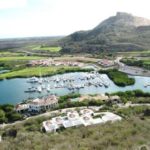A floating market
By Victor Block
I knew the Caribbean island of Curacao is unfamiliar to many Americans, but the flight attendant’s announcement still caught me by surprise. As she said where the plane was heading, she stumbled over the destination, then sheepishly admitted, “I don’t know how to say the name of that island.”
Maybe the challenging pronunciation – cure-a-sow – is a turn-off. Perhaps its lack of as many magnificent beaches as other islands convinces sun-seekers to head elsewhere.
But the relatively few Americans who go there are richly rewarded. Begin with the island’s intriguing history and cultural tapestry. Add some of the best diving and snorkeling anywhere. Throw in an architectural gem of a mini-city that combines tropical touches with European flair, along with an enticing choice of outdoor activities and extremely friendly people.
In my opinion, the beaches get a bum rap. After all, how many do you need during a short stay? The three dozen-plus on Curacao include both expansive stretches and tiny swatches nestled in little coves.
My favorites are Grote (Big) Knip and Kleine (Little) Knip. Both offer soft white sand and shade provided by large trees, and are lapped by stunning turquoise waters.
Grote and Klein Knip are not the only places with Dutch names, as the island’s history and culture are closely entwined with what today is the Netherlands.
The earliest known inhabitants were Arawak Indians who arrived some 6,000 years ago. They were followed by Spanish explorers who came in 1499 seeking gold and other treasure. Finding none, they included Curacao on a list of islas inutiles (“useless islands”).
The Dutch were after something else. Attracted by Curacao’s deep-water port, they seized the island in the early 17th century. That launched Curacao’s long tradition as a trading center. Trade attracted immigrants from around the world, creating the ethnic melting pot that today includes people from over 50 nationalities.
Wealthy Dutch traders built stately plantation homes, some of which have been restored and house restaurants, art galleries and museums. The island’s history also may be explored in other ways. The obvious starting point is Willemstad, the storybook capital.
Architecture is its main claim to fame, featuring a tropical adaptation of 17th-century Dutch design adorned with fanciful gables, arcades and columns. Buildings are painted in a virtual fruit-salad of pastel colors.
That chromatic explosion is attributed to a governor-general who suffered headaches that he blamed on the glare of white paint. He decreed that only pastel colors be used. Some accounts say the fact that he owned a paint factory contributed to his decision.
Willemstad is best seen on foot. The main neighborhoods are linked by the Queen Emma Bridge, one of three named after Dutch monarchs. The others are the Queen Juliana Bridge over the harbor, at 200 feet the highest in the Caribbean, and Queen Wilhelmina Bridge.
A floating market of small wooden boats from Venezuela overlooks a small canal. Their crews sell fresh fish, fruit and vegetables from stands erected on the sidewalk adjacent to the vessels.
Not far away, Mikve Israel-Emanuel Synagogue, built in 1732, claims the honor of the oldest synagogue in continuous use in the Western Hemisphere. Sand that covers the floor is said to symbolize the wandering of Israelites in the desert during the Exodus. The congregation uses Torahs that are more than 300 years old, and keeps in protective storage several dating back to the 15th century.
A number of other small museums are little gems in terms of their collections. The Curacao Museum provides an overview of the island’s lifestyles and customs. The Maritime Museum traces more than 500 year of seagoing history with maps dating back as far as 1666, navigation equipment and highly detailed ship models.
For me, the piece de resistance is an often-overlooked gem in Willemstad. The Sonesta Kura Hulanda Village resort is a virtual neighborhood of meticulously restored 18th and 19th century Dutch Colonial houses set among lovely courtyards.
It encompasses the Kura Hulanda Museum, which focuses upon the predominant cultures of Curacao, and their African roots. Exhibits include areas devoted to the Origin of Man, West African Empires and the African slave trade. Most moving is a full-size replica of the hold of a slave ship, which captures the horrors of how people were crowded onto wooden platforms where they could hardly sit, much less stand.
It doesn’t take long after leaving Willemstad to encounter a very different environment. In contrast to the multicolored city, much of the surrounding landscape is barren and dry, and in places more closely resembles a moonscape than a Caribbean island.
One green oasis is Christoffel Park, which is laced with pleasant trails. Hikers are greeted by countless small lizards and an occasional iguana that slither across the path. Skipping the heart-pounding climb to the top of 1,230-foot Mount Christoffel, I enjoyed the tranquil setting of more level terrain.
I followed my stroll with a dip in the sea. The beach from which I swam was pleasant enough and, unlike many on other Caribbean islands, virtually deserted. Maybe, I concluded, there’s something good to be said for Curacao’s low profile as an inviting Caribbean vacation destination.
For more information call the Curacao Tourist Board at (800) 328-7222 or visit curacao.com.













